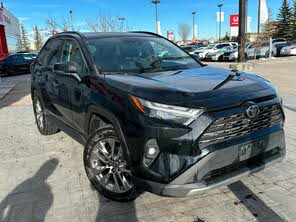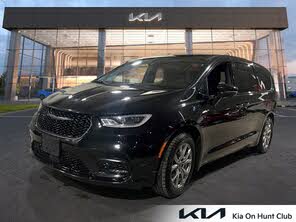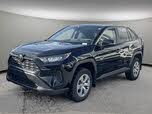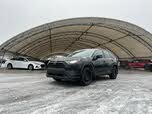2023 Toyota RAV4 vs 2022 Chrysler Pacifica Hybrid
Overview | |
MSRP$49,000 | MSRP$28,275 |
Average price$43,789 | Average price$37,966 |
Listings31 | Listings274 |
Ratings & Reviews | |
User Reviews | User Reviews |
Expert reviews7.5 out of 10 | Expert reviews7.8 out of 10 |
Pros
| Pros
|
2022 Chrysler Pacifica Hybrid Reviews SummaryThe summer of 2022 has been a doozy. Gas prices went sky high and heat waves rolled across the country. If you’re rethinking the purchase of a three-row SUV and trying to find a fuel-efficient solution that emits greenhouse gas emissions only part of the time, the seven-passenger Chrysler Pacifica Hybrid might be a good solution. It doesn’t offer all-wheel drive (AWD) as other Pacificas do, but it has a plug-in hybrid powertrain supplying a Natural Resources Canada-rated 51 kilometres of electric range before the gasoline V6 engine fires up to deliver 8.0 litres per 100 kilometres in combined driving. | |
2023 Toyota RAV4 Reviews SummaryThe RAV4 was last revised for 2019, and Toyota takes the if-it-ain’t-broke approach for the new model year, retaining the well-reviewed styling while updating the frequently maligned infotainment system of yesteryear. This review focuses on the gas-powered RAV4. The RAV4 Hybrid and the plug-in hybrid (PHEV) RAV4 Prime are each covered separately. | |
No video found | |
Popular Features & Specs | |
Engine3.6L 260 hp V6 Hybrid | Engine2.5L 203 hp I4 |
Drive TrainFWD | Drive TrainFWD |
Seating Capacity7 | Seating Capacity5 |
EV Battery Capacity16 kWh | EV Battery Capacity |
MPG City29 | MPG City27 |
MPG Highway30 | MPG Highway34 |
Battery Charge Time (120V)14 hours | Battery Charge Time (120V) |
Battery Charge Time (240V)2 hours | Battery Charge Time (240V) |
Engine | |
Engine Name3.6L 260 hp V6 Hybrid | Engine Name2.5L 203 hp I4 |
Battery Charge Time (120V)14 hours | Battery Charge Time (120V) |
Battery Charge Time (240V)2 hours | Battery Charge Time (240V) |
DrivetrainFWD | DrivetrainFWD |
Fuel Economy | |
EV Battery Capacity16 kWh | EV Battery Capacity |
MPG City29 | MPG City27 |
MPG Highway30 | MPG Highway34 |
Interior | |
Seating Capacity7 | Seating Capacity5 |
Safety | |
Front Crash Overall4 | Front Crash Overall4 |
Side Crash Overall5 | Side Crash Overall5 |
Dimensions & Capacity | |
Cargo Space32.3 cu ft | Cargo Space37.6 cu ft |
Curb Weight5010 lbs | Curb Weight3370 lbs |
Height69.9 in | Height67.0 in |
Length204.3 in | Length180.9 in |
Width90.4 in | Width73.0 in |
Wheelbase121.6 in | Wheelbase105.9 in |
Maximum Payload1313 lbs | Maximum Payload1230 lbs |
Number of doors4 | Number of doors4 |
Maximum Towing Capacity | Maximum Towing Capacity1500 lbs |
Overview | ||
MSRP | $49,000 | $28,275 |
Average price | $43,789 | $37,966 |
Listings | ||
Ratings & Reviews | ||
User reviews | ||
Expert reviews | 7.5 out of 10Read full review | 7.8 out of 10Read full review |
Pros & cons | Pros
| Pros
|
Summary | The summer of 2022 has been a doozy. Gas prices went sky high and heat waves rolled across the country. If you’re rethinking the purchase of a three-row SUV and trying to find a fuel-efficient solution that emits greenhouse gas emissions only part of the time, the seven-passenger Chrysler Pacifica Hybrid might be a good solution. It doesn’t offer all-wheel drive (AWD) as other Pacificas do, but it has a plug-in hybrid powertrain supplying a Natural Resources Canada-rated 51 kilometres of electric range before the gasoline V6 engine fires up to deliver 8.0 litres per 100 kilometres in combined driving. | The RAV4 was last revised for 2019, and Toyota takes the if-it-ain’t-broke approach for the new model year, retaining the well-reviewed styling while updating the frequently maligned infotainment system of yesteryear. This review focuses on the gas-powered RAV4. The RAV4 Hybrid and the plug-in hybrid (PHEV) RAV4 Prime are each covered separately. |
Video | No video found | |
Popular Features & Specs | ||
Engine | 3.6L 260 hp V6 Hybrid | 2.5L 203 hp I4 |
Drive Train | FWD | FWD |
Seating Capacity | 7 | 5 |
EV Battery Capacity | 16 kWh | |
MPG City | 29 | 27 |
MPG Highway | 30 | 34 |
Battery Charge Time (120V) | 14 hours | |
Battery Charge Time (240V) | 2 hours | |
Engine | ||
Engine Name | 3.6L 260 hp V6 Hybrid | 2.5L 203 hp I4 |
Battery Charge Time (120V) | 14 hours | |
Battery Charge Time (240V) | 2 hours | |
Drivetrain | FWD | FWD |
Fuel Economy | ||
EV Battery Capacity | 16 kWh | |
MPG City | 29 | 27 |
MPG Highway | 30 | 34 |
Interior | ||
Seating Capacity | 7 | 5 |
Safety | ||
Front Crash Overall | 4 | 4 |
Side Crash Overall | 5 | 5 |
Dimensions & Capacity | ||
Cargo Space | 32.3 cu ft | 37.6 cu ft |
Curb Weight | 5010 lbs | 3370 lbs |
Height | 69.9 in | 67.0 in |
Length | 204.3 in | 180.9 in |
Width | 90.4 in | 73.0 in |
Wheelbase | 121.6 in | 105.9 in |
Maximum Payload | 1313 lbs | 1230 lbs |
Number of doors | 4 | 4 |
Maximum Towing Capacity | 1500 lbs | |

By: CarGurus + AI
At CarGurus, our team of experienced automotive writers remain at the heart of our content operation, conducting hands-on car tests and writing insightful guides that are backed by years of industry experience. To complement this, we are harnessing AI to make our content offering more diverse and more helpful to shoppers than ever. To achieve this, our AI systems are based exclusively on CarGurus content, ratings and data, so that what we produce is both unique to CarGurus, and uniquely helpful to car shoppers.







































